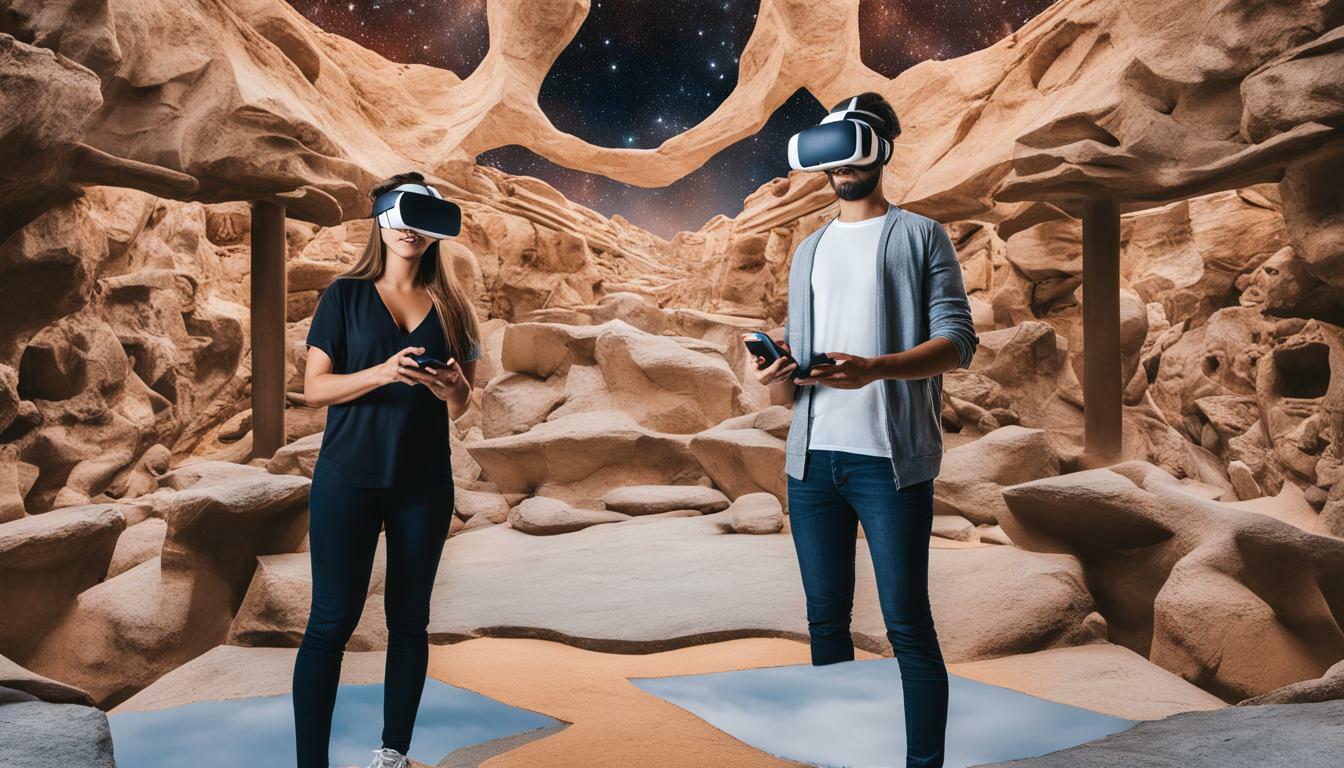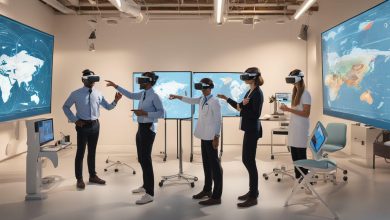
Welcome to the future of technology, where immersive technologies like augmented reality (AR) and virtual reality (VR) are set to transform the way we experience the world around us. While these two technologies share some similarities, they also have fundamental differences that set them apart. In this article, we will explore the world of AR and VR, their potential impact on immersive technologies, and the future developments that lie ahead.
As AR and VR continue to gain popularity, advancements in technology are enabling these immersive experiences to become more realistic and accessible. The potential for these technologies to shape our future reality is vast, and we are only beginning to scratch the surface of what is possible. Let’s dive deeper into the world of AR and VR to uncover their unique applications and potential for the future.
Understanding Augmented Reality and Virtual Reality
Emerging technologies such as augmented reality (AR) and virtual reality (VR) are transforming the way we interact with the world. AR and VR offer immersive experiences that were once unimaginable, making them increasingly popular across various industries. In this section, we’ll define AR and VR, explore their applications, and discuss the emerging technologies in this field.
Augmented Reality Applications
AR involves overlaying virtual information on the real world. Its applications are broad and varied, from navigation systems that guide us through unfamiliar environments to healthcare applications that aid in medical training. AR finds use in architecture and interior design when specialists use it to simulate building designs and interiors before implementing them. The technology has also found its way into shopping, allowing customers to experience products before buying them.
Virtual Reality Devices
VR, on the other hand, offers a fully immersive 3D experience. Users wear VR headsets that transport them to alternate realities, making it ideal for gaming and entertainment. The technology also finds application in education and training, providing safe and realistic simulations for training in various fields like aviation and healthcare. Emerging technologies such as haptic suits and gloves are helping to make these simulations more lifelike and interactive.
Emerging Technologies
AR and VR are rapidly evolving with the advent of new technologies. For instance, 5G networks and edge computing are enabling more powerful and responsive AR and VR experiences. Apple’s ARKit and Google’s ARCore are making it easier and more affordable for developers to create AR applications for smartphones. Additionally, new hardware such as VR treadmills and full-body motion capture suits are enhancing VR gaming experiences and expanding the possibilities of VR in other fields.
Augmented Reality in Everyday Life
Augmented reality applications are becoming increasingly common in our daily lives, enhancing our reality and providing new immersive experiences. From navigation apps to shopping experiences, AR is changing the way we interact with the world around us.
One practical application of AR is in navigation. With AR-enabled GPS apps, users can point their phone camera at their surroundings and see directions overlaid on the real world. This technology provides a more intuitive and engaging way to navigate, making it easier to find and reach destinations.
AR is also transforming the shopping experience. Some retailers are using AR to create immersive product showcases, allowing customers to virtually try on clothes, see furniture in their homes, and even visualize how makeup will look on their faces. These experiences provide a more engaging and interactive way to shop, leading to increased customer satisfaction and sales.
In education, AR is being used to create immersive learning experiences. By overlaying digital content onto real-world objects, AR can enhance traditional classroom education and provide a more engaging and interactive way to learn. For example, students can use AR apps to explore a 3D model of the solar system or understand complex scientific concepts through interactive visualizations.
Entertainment is another area where AR is providing new immersive experiences. AR games and apps offer users an interactive and engaging way to experience their favorite movies, books, and TV shows. For example, the Pokemon Go game became a global phenomenon in 2016, blending real-world locations with digital creatures and battles.
Overall, AR offers a wide range of immersive experiences and practical applications for everyday life. As the technology continues to evolve, we can expect to see even more innovative uses of AR in the future.
Virtual Reality Gaming and Entertainment
Virtual reality (VR) has revolutionized the gaming and entertainment industry by providing immersive experiences. With the use of VR devices, players can live the game and feel like they are part of it. VR gaming provides a unique level of interactivity that traditional gaming cannot match, making it a popular trend in the gaming industry.
VR gaming is not limited to just games. It is also used for entertainment purposes, such as VR concerts and events. Fans can attend concerts and events from the comfort of their own homes, and feel like they are present at the event.
Hardware and software advancements have contributed significantly to the growth of VR gaming and entertainment. The development of high-end VR devices, such as Oculus, has increased the quality of VR experiences. Additionally, game developers are creating games specifically designed for VR, providing players with unique and immersive experiences.
Immersive Experiences
One of the main reasons for the popularity of VR gaming and entertainment is the immersive experiences they provide. VR devices allow players to interact with the virtual environment, giving them a feeling of being present in the game. Unlike traditional gaming, players are not just controlling a character on a screen; they are the character, and they control all its actions. This level of immersion creates a sense of excitement and adrenaline, making it an unforgettable experience for players.
“With the use of VR devices, players can live the game and feel like they are part of it.”
VR gaming and entertainment also provide a social aspect. Multiplayer games allow friends to join and play together, even if they are in different locations. Additionally, VR concerts and events provide fans with the opportunity to interact with other fans and share their experiences.
In conclusion, VR gaming and entertainment have transformed the way we experience games and entertainment. With the use of VR devices and the development of VR-specific games, players can immerse themselves in virtual worlds like never before. The unique experiences and social aspects of VR gaming and entertainment make it a popular trend that will continue to evolve and shape the entertainment industry.
Augmented Reality in Business and Industry
Augmented reality (AR) is transforming various industries, including manufacturing, healthcare, architecture, and retail. With its ability to enhance the real world with computer-generated visuals, AR is providing new opportunities for businesses to improve their operations and engage with customers.
In manufacturing, AR is being used for assembly line work, allowing workers to view 3D models of products and their components in real-time, reducing errors and increasing efficiency. AR is also being used in healthcare for training medical students and providing surgeons with real-time feedback during surgery.
The architecture industry is utilizing AR for building designs, allowing architects to overlay 3D models onto real-world environments for better visualization and collaboration. AR is also becoming popular in retail, with businesses using it for marketing and shopping experiences. For example, customers can try on virtual clothing or view furniture in their own homes before making a purchase.
As AR technology continues to develop, the potential future applications for businesses are vast. For example, AR could be used for remote collaboration, allowing team members to work together from anywhere in the world. AR could also enhance customer service by providing real-time information and support to customers.
Overall, the future of technology is closely tied to the development of immersive technologies like augmented reality. As more businesses and industries adopt AR applications, the potential for innovation and growth in these fields is significant.
Virtual Reality in Education and Training
Virtual reality technology has become increasingly prevalent in the education and training industries, offering immersive experiences that are changing the way we learn and develop new skills. With the help of virtual reality devices, learners are able to engage in realistic simulations that mimic real-life scenarios, providing a safe and controlled environment for experimentation and practice.
One of the most significant benefits of VR in education and training is the ability to create immersive learning environments that allow for deeper engagement and retention of information. Studies have shown that learners who use VR technology for training purposes demonstrate higher levels of knowledge retention and application than traditional teaching methods.
VR is especially valuable in training for high-risk or complex jobs, such as in healthcare or aviation, where mistakes can have life-threatening consequences. By providing hands-on training in virtual simulations, learners can gain valuable experience without putting themselves or others at risk. Additionally, VR can significantly reduce training costs by eliminating the need for expensive equipment or physical training spaces.
One example of VR in education is the use of VR headsets in history classes. With the help of VR devices, students can experience historical events as if they were there, making learning more engaging and memorable. Similarly, VR is being used to teach practical skills, such as welding or surgery, where learners can practice without the risk of damaging materials or patients.
While the potential benefits of VR in education and training are clear, there are also challenges to its implementation. One significant challenge is the high cost of VR devices, which can be a barrier for some institutions and learners. Additionally, some learners may find VR simulations disorienting or uncomfortable, which can impact their ability to learn effectively.
Overall, virtual reality is transforming the way we learn and train for the future. As VR devices become more accessible and affordable, we can expect to see even wider adoption of this technology in both educational and professional contexts, offering new and innovative ways to enhance our skills and knowledge through immersive experiences.
The Future of Immersive Technologies
The future of technology is both exciting and uncertain, with endless possibilities waiting to be explored. Augmented reality and virtual reality are two immersive technologies that are rapidly advancing and evolving, poised to shape our future reality in significant ways.
While augmented reality and virtual reality have distinctive differences, they share a common goal of creating immersive experiences for users. Augmented reality enhances our existing reality by overlaying digital information on top of the physical world, while virtual reality transports users to entirely new digital environments. Both technologies have the potential to revolutionize the way we interact with the world around us.
The future of immersive technologies is likely to be one where AR and VR will become more integrated, enabling users to seamlessly transition between the two. We may also see advancements in hardware and software, such as the development of lightweight AR glasses or more sophisticated VR headsets, providing users with even more immersive experiences.
As AR and VR continue to advance, they are also likely to integrate with other emerging technologies, such as artificial intelligence and the Internet of Things. This integration will likely lead to even more incredible possibilities and applications, further enhancing our reality and transforming the way we live and work.
The future of immersive technologies is undoubtedly exciting, and AR and VR will undoubtedly play a significant role in shaping this future. It is up to businesses and individuals to adapt to these technologies and embrace the possibilities they offer.
Conclusion
As we have seen, immersive technologies like augmented reality and virtual reality are set to revolutionize the way we live, work, and play. With their ability to create immersive experiences, these technologies have the potential to enhance our reality in numerous ways.
The future of immersive technologies is exciting, with new developments and advancements on the horizon. We can expect to see a greater integration of AR and VR with other emerging technologies like artificial intelligence and the internet of things.
It is important for individuals and businesses to stay informed and adapt to these advancements in order to remain competitive and take advantage of the potential benefits. The future of immersive technologies is bright, and it is up to us to shape it.








